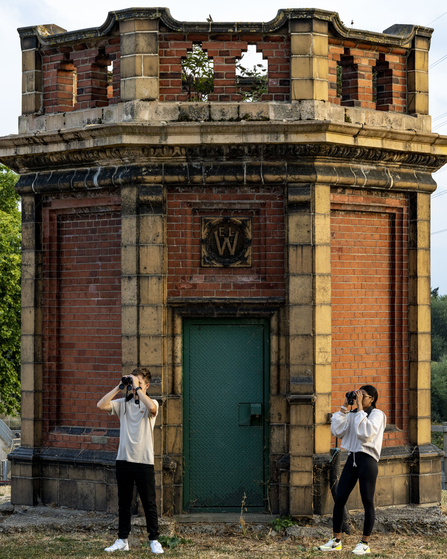However, I like to think birding culture is changing for the better; revolutionised by communication and information sharing with technical developments and tools such as eBird* which brings a broader sense of community. A growing birding community that is more diverse, more inclusive and more connected than it was a few decades ago. Perception is changing and things are heading in the right direction with young women, people of colour and many others who previously felt excluded from natural spaces becoming involved through initiatives such as Flock Together.

Bird watching at Walthamstow Wetlands using the excellent Leica Trinovid 10 x 42s'
Photo credit: Tom Clazie Flynn
With an increase in popularity, is birding cool now? Is birding fashionable? It certainly is a far cry from khaki everything and zip-off trousers. Accessibility to information has played a huge part in positive change, aiding species identification, understanding of migratory patterns and so on, but it does not come without its own issues. Birders can receive a notification of a rare bird within minutes of its first sighting. This has fuelled an increase in the number of spur-of-the-moment trips people make to tick off rare or vagrant birds (a species that is outside their wintering and breeding area). For some, this becomes an obsessive hobby, Twitching, and this behaviour has raised increasing concerns about the negative impact it could have on an already warming planet.
Many birders are becoming increasingly aware of their own birding carbon footprint and as a conservationist, I tend to side with local birding. This isn’t to say I am perfect, I could do a lot more to reduce my footprint to combat the climate crisis. But it is encouraging to see birders becoming more climate-conscious and re-finding joy in nature close to home. Their own patches.

Two people sit on a bench using the Leica Trinovid 10 x 42s' to birdwatch
Photo credit: Tom Clazie Flynn
So what is a patch?
A patch can be anything: your local park, a scrubby bit next to a golf course, a stretch of river or canal, or a reservoir like here at Walthamstow or Woodberry Wetlands. It can be any green/blue space that is local to you and you can visit regularly. Even in London, you should be easily able to find one as the city is remarkably green and home to an abundance of nature.
Your own patch is rewarding, climate-friendly, a good way to learn and can contribute to science. Walking your routine loop, you will quickly become familiar with your place, and start to notice things such as that wren that is always belting its song out from the same scrubby bit in the corner that everyone else ignores. I also think patch birding is the best way to experience seasonal changes and in particular migration, as you experience the day-to-day. Here at the Wetlands, it is the first common tern to gracefully arrive on the shores of the reservoirs in April to the first swift that marks the start of summer, and all the way into winter where handsome goldeneyes choose to feed on the ice-free waters.

Bird watching with the Leica Trinovid 10 x 42s
Photo credit: Tom Clazie Flynn
Over the years, you will improve your knowledge of the area, learn its comings and goings, meet new people and build a personal connection with its nature and wildlife. If you're lucky you might be rewarded and discover your own rare visitor to your patch as birds really can appear in the unlikeliest of places.
To take your observation notes one step further you can submit your sightings to apps such as eBird, a citizen scientist project that collates data that contributes to conservation. For example, without 100s of people submitting their waxwing records, it would be difficult to monitor irruption years. An irruption year is when large numbers visit the UK in winter when there is a short supply of rowan berries in Scandinavia. Your records tell us the timings, how many and how long for.
As its New Year’s Day, there is no better time to find your own patch and kick-start your annual list. It's good to keep a life and annual patch list as it renews excitement for ticking off the common species such as tits and robins at the start of each year. So, treat yourself to a pair of binoculars (I highly recommend Leica, a great range of kit with superb optics and they have payment plans to help with purchasing your chosen pair that will stay with you for many years) , get out there and you might just have a birding New Year’s Day to remember.
Happy birding 2023.
*eBird is a recording tool for citizen scientist birders to input their bird observations to an online database providing researchers with data about bird distribution and abundance.

Thank you to Leica Sports Optics for supporting our activities at Walthamstow Wetlands
Instagram: leicanature
Facebook: Leica.Sport.Optics
Twitter: LeicaBirding

